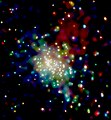File:The Young Stellar Cluster RCW 38 in X-ray.jpg

Original file (2,100 × 2,279 pixels, file size: 559 KB, MIME type: image/jpeg)
| This is a file from the Wikimedia Commons. Information from its description page there is shown below. Commons is a freely licensed media file repository. You can help. |
Summary
| DescriptionThe Young Stellar Cluster RCW 38 in X-ray.jpg |
Description: This Chandra image covers a region about 5 light years across and shows many young stars with hot upper atmospheres. In addition to the point-like emission from the stars, the image revealed a diffuse cloud enveloping the star cluster. The X-ray spectrum of the cloud shows an excess of high-energy X-rays. This excess indicates that these X-rays come from trillion-volt electrons moving in a magnetic field. The presence of these extremely energetic particles could dramatically change the chemistry of the disks that will eventually form planets around stars in the cluster. Evidence in the form of short-lived radioactive nuclei found in meteorites suggests that our solar system was immersed for a time in a sea of energetic particles. Creator/Photographer: Chandra X-ray Observatory NASA's Chandra X-ray Observatory, which was launched and deployed by Space Shuttle Columbia on July 23, 1999, is the most sophisticated X-ray observatory built to date. The mirrors on Chandra are the largest, most precisely shaped and aligned, and smoothest mirrors ever constructed. Chandra is helping scientists better understand the hot, turbulent regions of space and answer fundamental questions about origin, evolution, and destiny of the Universe. The images Chandra makes are twenty-five times sharper than the best previous X-ray telescope. NASA's Marshall Space Flight Center in Huntsville, Ala., manages the Chandra program for NASA's Science Mission Directorate in Washington. The Smithsonian Astrophysical Observatory controls Chandra science and flight operations from the Chandra X-ray Center in Cambridge, Massachusetts. Medium: Chandra telescope x-ray Date: 2002 Persistent URL: chandra.harvard.edu/photo/2002/rcw38/ Repository: Smithsonian Astrophysical Observatory Gift line: NASA/CXC/CfA/S.Wolk et al. Accession number: rcw38_xray |
| Date | |
| Source | A young star cluster 6000 light years from Earth in the constellation Vela. |
| Author | Smithsonian Institution from United States |
| Permission (Reusing this file) |
Smithsonian Institution @ Flickr Commons |
Licensing
This image was taken from Flickr's The Commons. The uploading organization may have various reasons for determining that no known copyright restrictions exist, such as: No known copyright restrictionsNo restrictionshttps://www.flickr.com/commons/usage/false
More information can be found at https://flickr.com/commons/usage/. Please add additional copyright tags to this image if more specific information about copyright status can be determined. See Commons:Licensing for more information. |
| This image was originally posted to Flickr by Smithsonian Institution at https://flickr.com/photos/25053835@N03/2940665939. It was reviewed on 14 September 2016 by FlickreviewR and was confirmed to be licensed under the terms of the No known copyright restrictions. |
14 September 2016
Captions
Items portrayed in this file
depicts
some value
30 September 2008
File history
Click on a date/time to view the file as it appeared at that time.
| Date/Time | Thumbnail | Dimensions | User | Comment | |
|---|---|---|---|---|---|
| current | 07:34, 14 September 2016 |  | 2,100 × 2,279 (559 KB) | Vanished Account Byeznhpyxeuztibuo | Transferred from Flickr via Flickr2Commons |
File usage
The following 2 pages use this file:
Global file usage
The following other wikis use this file:
- Usage on fa.wikipedia.org
- Usage on ko.wikipedia.org
- Usage on mk.wikipedia.org
- Usage on th.wikipedia.org
- Usage on tr.wikipedia.org
Metadata
This file contains additional information, probably added from the digital camera or scanner used to create or digitize it.
If the file has been modified from its original state, some details may not fully reflect the modified file.
| Image title |
|
|---|---|
| Author | Chandra X-ray Observatory Center |
| Copyright holder | http://chandra.harvard.edu/photo/image_use.html |
| Headline | A young star cluster 6000 light years from Earth in the constellation Vela. |
| Credit/Provider | NASA/CXC/CfA/S.Wolk et al. |
| Source | Chandra X-ray Observatory |
| Online copyright statement | |
| Usage terms | |
| Date and time of data generation | 18 December 2002 |
| Width | 2,100 px |
| Height | 2,279 px |
| Bits per component |
|
| Compression scheme | LZW |
| Pixel composition | RGB |
| Orientation | Normal |
| Number of components | 3 |
| Horizontal resolution | 300 dpi |
| Vertical resolution | 300 dpi |
| Data arrangement | chunky format |
| Software used | Adobe Photoshop CS3 Macintosh |
| File change date and time | 10:34, 30 September 2008 |
| Color space | Uncalibrated |
| Image width | 2,100 px |
| Image height | 2,279 px |
| Exif version | 2.21 |
| Date and time of digitizing | 06:34, 30 September 2008 |
| Date metadata was last modified | 14:39, 8 October 2008 |
| Keywords | RCW 38 |
| Contact information | cxcpub@cfa.harvard.edu
60 Garden st. Cambridge, MA, 02138 USA |
| IIM version | 2 |
